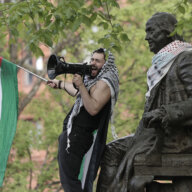Life-sizesilhouette cutouts filled Dilworth Park Thursday morning—a chilling representation of the hundreds of Philadelphia’s youths who had to be turned awayfrom a homeless shelter for lack of space. Covenant House, the city’s largest shelter serving exclusively homeless youth, served 516 young peoplelast year among its 51 beds. Cutouts of mothers, their children and adolescentswere brought to City Hall for one dayto communicate the tragedy ofthe546 youths who weren’t able to access Covenant House’s shelter or services. The pop-up installation”Am I Cut Out”was a collaborative effort between the shelter and art blog Street Dept. founder Conrad Benner, who said the numbers can feel “really obtuse.” “When you see them, we can see how this feels like,” Benner said. “It’s hard to not have a moment of pause and wonder what you can do.”
Youth homelessness is a tough figure to estimate, Covenant House’s Director of Corporate Partnerships TreacyHenry said. Two years ago, 4,000 public school students were reported to be experiencing homelessness, but that number doesn’t take into account young people who aren’t even registered in the district. “You’re not going to see them sleeping on a subway grate,” Henry said of the difficulty in gauging the scope of the problem, “They’re sleeping in abandoned area. They’re riding the 24 bus all night long because it’s a four-hour ride. They’re couch-surfing.” A point-in-time count conducted by the Department of Housing & Urban Development in 2014, which counts the number of sheltered and unsheltered homeless persons on one night, recorded just two homeless youths in the city, Henry said. The Philadelphia Department of Housing Services said the percentage of public school students who have experienced homelessness has increased by 73 percent from 2009 to 2013. But those are all just numbers. To John Ducoff, executive director of Covenant House, Thursday’s pop-up installation served as a striking visual reminder of all those who were “cut out” of a safe place to call home. “The challenge with this work is every one of these kids represents a young person who I failed,” Ducoff said, gesturing to the rows of cutouts. “It’s terrible.”
Covenant House operates two shelters in the city. One, a crisis center in Germantown; another, in Kensington, acts as a transitional home called the Rights of Passage Center, for young people to stabilize their lives before eventually leaving the shelter. Each day, kids land on their East Armat Street doorstep, seeking a meal, a warm bed and a brief respite from the dangers they face on the street,
Lovely Rawls is one of them. Earlier this year, her family made it clear she wasn’t welcome home anymore after she had to testify against her brother in court. She spent 36 hours on the streets, a brief portion of which was at a different shelter,before heading to Covenant House. “It was really heartbreaking,” the 22-year-old North Philly woman said. “I cried the whole first night I was in the shelter. And I cried when I got to Covenant House because everybody was so nice.” Rawls now lives in Covenant’s Kensington home with a roommate. She has a job and is soon getting her own apartment. She plans to attend nursing school. And she said she’s working on healingthe wounds with her family, too. Covenant House saved her, she said.
“We all get together, and we’re each other’s family, because our families turned us away,” Rawls said. “And when I look around and see us all laughing and joking around with each other, I’m home. It’s my family.”





























